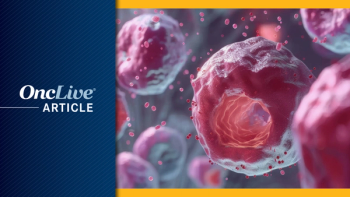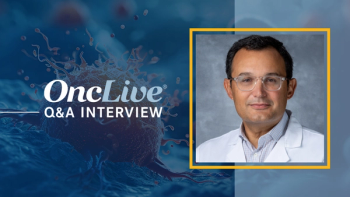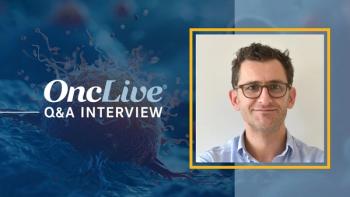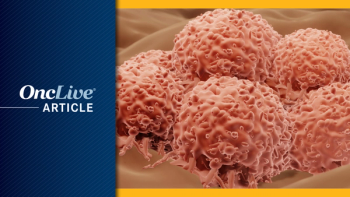
Quizartinib Data Move FLT3 Inhibition Forward in AML Paradigm
FLT3 inhibition continues to be explored as a therapeutic option for patients with FLT3-mutant acute myeloid leukemia, with quizartinib at the forefront following intriguing results of the phase III QuANTUM-R trial.
FLT3 inhibition continues to be explored as a therapeutic option for patients with FLT3-mutant acute myeloid leukemia (AML), with quizartinib at the forefront following intriguing results of the phase III QuANTUM-R trial, experts discussed during an OncLive® Peer Exchange®.
FLT3 is expressed in approximately 30% of all patients with AML,1 leading to an area of active investigation. It has been determined that FLT3 mutations can be divided into internal tandem duplications (FLT3-ITD) in or near the juxtamembrane domain of the receptor, or as point mutations that lead to single amino acid substitutions that occur in the activation loop of the tyrosine kinase domain (FLT3-TKD).
The first of the FLT3 inhibitor regulatory approval stream began with the FDA approval of midostaurin (Rydapt) for the treatment of adult patients with newly diagnosed FLT3-positive AML in combination with standard cytarabine and daunorubicin induction and cytarabine consolidation. The FLT3 inhibitor was approved along with a companion diagnostic, the LeukoStrat CDx FLT3 Mutation Assay, to test for FLT3 mutations in patients with AML.
Other type I inhibitors that have been evaluated in patients with FLT3-mutant AML include lestaurtinib, sunitinib (Sutent), crenolanib, and gilteritinib (Xospata), which was approved by the FDA in November 2018 as a therapy for adult patients with FLT3 mutation—positive relapsed or refractory disease.
The gilteritinib approval was based on findings from the ADMIRAL trial, in which 138 adult patients with FLT3-positive relapsed/refractory AML received the FLT3 inhibitor orally at 120 mg daily. At a median follow-up of 4.6 months, the rate of complete remission (CR) or CR with partial hematologic recovery was 21% (n = 29; 95% CI, 14.5-28.8).2
Type II inhibitors that have been evaluated in this space include sorafenib (Nexavar), ponatinib (Iclusig), and quizartinib. The FDA granted a priority review designation to a new drug application (NDA) for quizartinib in November 2018 for the treatment of adult patients with relapsed/refractory FLT3-ITD—positive AML. Under the Prescription Drug User Fee Act, the FDA will decide on the NDA by May 25, 2019.
The designation is based on findings from the pivotal phase III QuANTUM-R trial, which explored quizartinib compared with salvage chemotherapy in patients with FLT3-ITD—positive relapsed/refractory AML following frontline treatment with or without hematopoietic stem cell transplantation (HSCT). Updated data from the study presented at the 2018 American Society of Hematology Annual Meeting showed that the overall survival (OS) benefit with quizartinib in this population was reported across patient subgroups and reproduced consistently across sensitivity analyses.3
In the open-label QuANTUM-R study, patients with FLT3-ITD—positive relapsed/refractory AML were randomized in a 2:1 ratio to receive once-daily quizartinib at 60 mg, with a 30-mg lead-in (n = 245) or investigators’ choice of salvage chemotherapy that was selected by physicians prior to randomization. Chemotherapy regimens included low-dose cytarabine (n = 29); the combination of mitoxantrone, etoposide, and cytarabine (MEC; n = 40); or the combination of fludarabine, cytarabine, and granulocyte colony-stimulating factor with idarubicin (FLAG-IDA; n = 53).
Baseline patient characteristics were well balanced across the treatment arms. The median patient age in the quizartinib arm was 55 years (range, 19-81), and 89% had an ECOG performance status of 0 or 1. Additionally, 33% of patients were refractory to prior therapy, 23% had relapsed after remission with HSCT, and 45% had relapsed after remission without HSCT.
Also, among patients receiving quizartinib, the FLT3-ITD variant allele frequency ranges included <3% (1%); ≥3% to ≤25% (27%); >25% to ≤50% (35%); and >50% (37%). Cytogenetic risk status included favorable (5%), intermediate (78%), unfavorable (9%), and unknown (8%).
Results showed that, at a median follow-up of 23.5 months, the median OS was 6.2 months (95% CI, 5.3-7.2) with quizartinib compared with 4.7 months (95% CI, 4.0-5.5) with salvage chemotherapy (HR, 0.76; 95% CI, 0.58-0.98; stratified log-rank test, 1-sided P = .0177). Earlier reported data from QuANTUM-R showed that quizartinib had led to a 24% reduction in the risk of death versus salvage chemotherapy.
This OS benefit was upheld across 3 prespecified sensitivity analyses. In the first, which censored for the effect of transplant, the median OS with quizartinib versus salvage chemotherapy was 5.7 months versus 4.6 months (HR, 0.79; 95% CI, 0.59-1.05; P = 0.519). An analysis censoring for the use of other FLT3 inhibitors showed a median OS of 6.6 versus 5.0 months, respectively (HR, 0.74; 95% CI, 0.55-0.99; P = .0203).
The third sensitivity analysis examined the per-protocol set (patients who were randomized and treated without significant protocol deviations). For this assessment, the median OS was 6.2 months with quizartinib versus 4.6 months with salvage chemotherapy (HR, 0.75; 95% CI, 0.57-1.00; P = .0246).
The OS benefit was also demonstrated across several patient subgroups. Among patients who had prior allogeneic HSCT, findings showed that the median OS was 5.3 months with quizartinib compared with 4.0 months with salvage chemotherapy. In those without prior allogeneic HSCT, the median OS was 6.9 versus 5.2 months. The OS benefit was also shown across subgroups defined by AML risk scores, including intermediate (6.2 vs 4.6 months) and unfavorable (9.4 vs 5.8 months).
In subgroups that were defined by response to prior therapy, the median OS was 6.5 vs 4.7 months in patients who relapsed with no HSCT; 7.9 vs 5.4 months in refractory patients; and 5.1 versus 4.0 months in patients who relapsed post HSCT.
The benefit with quizartinib versus salvage chemotherapy was also observed across subgroups defined by varying allelic ratio, age, sex, and AML history.
The median event-free survival was 1.4 months (95% CI, 0.0-1.9) with quizartinib versus 0.9 months (95% CI, 0.4-1.3) with salvage chemotherapy (HR, 0.90; 95% CI, 0.70-1.16; stratified log-rank test, 1-sided P = .1071).
The overall response rate was 69% with quizartinib versus 30% with salvage chemotherapy. The composite complete remission (CRc) rate was 48% versus 27% and the partial response (PR) rate was 21% versus 3%, respectively. The median duration of CRc was 12.1 weeks versus 5.0 weeks, respectively.
Prior data from the trial showed that the best response was CRc in 45% of patients with quizartinib and 27% with chemotherapy; CR was achieved by 4% of patients, and 4% of patients had CR with incomplete platelet recovery (CRp).4 CRi was reported for 40% of patients, and the PR rate was seen in 21% of quizartinib-treated patients, which elicited a 69% ORR. Twenty-five percent of patients showed no response, and 5% were not evaluated.
With salvage chemotherapy, the best response was CRc in 27% of patients comprising 1% CR, 0 CRp, and 25% CRi. Moreover, 3% of patients showed a PR, yielding an ORR of 30%; no response was observed in 37% of patients on salvage chemotherapy, and 33% were not evaluated.
“And it met its primary endpoint,” said Mark J. Levis, MD, PhD, leader of the Hematologic Malignancies and Bone Marrow Transplant Program at Sidney Kimmel Comprehensive Cancer Center and a professor of oncology at John Hopkins Medicine. “You look at the curves and yes, it is dramatic. Does it cure everybody? Absolutely not. The responses are primarily CRi. So, the population was a dreadful population, of course. They were newly relapsed, within 6 months’ remission duration, and that’s a disaster, or they were primary refractory.”
Of the patients who were randomized to receive chemotherapy, 23% withdrew their consent of the trial. That could have affected the survival difference, hypothesized Harry Erba, MD, PhD, clinical investigator in the Division of Hematologic Malignancies and Cellular Therapy in the Department of Medicine, director of the Leukemia Program, and director of Phase I Development in Hematologic Malignancies at Duke Cancer Institute.
“We had a very hard time enrolling to that study when it was opened for the same reason,” explained Naval G. Daver, MD, an oncologist in the Department of Leukemia at The University of Texas MD Anderson Cancer Center in Houston. “You had gilteritinib in parallel, crenolanib in parallel, and quizartinib, and other studies in parallel. So the patient would say, ‘Well, do you believe in FLT3?’”
Regarding safety, the most common grade ≥3 hematologic adverse events (AEs) in the quizartinib arm included thrombocytopenia (35% vs 34% in the salvage chemotherapy arm), anemia (30% vs 29%, respectively), neutropenia (32% vs 25%), febrile neutropenia (31% vs 21%), and leukopenia (17% vs 16%). The most common grade ≥3 nonhematologic AEs in the quizartinib arm compared with chemotherapy were nausea (3% vs 1%), fatigue (8% vs 1%), pyrexia (3% vs 4%), musculoskeletal pain (4% in each arm), vomiting (3% vs 1%), hypokalemia (12% vs 9%), and diarrhea (2% vs 3%). However, these AEs can be properly managed by dose adjustments, said Alexander E. Perl, MD, MS, an associate professor of medicine at the Hospital of the University of Pennsylvania.
Levis added that 60 mg of quizartinib is an appropriate dose. A laboratory and clinical study aimed at identifying the optimal dosing strategy for quizartinib identified 60 mg daily as the target dose for clinical efficacy as a single agent.5
“If you give 200 mg of quizartinib, which was the [maximum-tolerated dose], you will see a lot of QT prolongation, and some of it’s probably clinically significant, but that’s not what they tested,” Perl said. However, he cautioned, more research needs to be conducted on the necessary dosage to hit molecular targets and get antitumor responses and also be cautionary to avoid serious toxicities.
“But you have to be careful with FLT3 inhibitors. Mark [Levis] has spent a lot of his career saying, ‘What’s the right dose of this FLT3 inhibitor? Are we really hitting target? Are we hitting it very potently and all the way around the clock, you know, with around-the-clock inhibition at a potent level?’ Because you really need that to get an antileukemic response. And if you go down and you miss the mark for any reason, you could lose what the drug is there to do. So unless that toxicity is really important, you’ve got to be careful about that.”
The QuANTUM-R findings also have a clinically meaningful impact on getting patients to stem cell transplantation, which is an optimal treatment approach for patients with relapsed AML, Perl said. Patients on the quizartinib arm were more likely to be transplanted than those on the chemotherapy arm, he explained. “Because the numbers overall were small, but if you needed to get to transplant, which we think of as the best therapy for relapse to AML, you could do so much more easily,” said Perl. “There were many more patients transplanted in the quizartinib arm.”
Long-term follow-up data of QuANTUM-R will be required to determine what long-term survival outcomes will look like for patients who have been on quizartinib for 2 to 3 years or even longer, Daver said.
As a type 1 FLT3 inhibitor, gilteritinib is not as potent as quizartinib; however, it does carry clinical activity against FLT3-TKD mutations. “It’s a little less potent, and, in fact, I think going forward, we’re going to have to find out how we use these drugs in different situations,” Levis said.
Overall, the CRi rates in the relapsed/refractory setting suggest that quizartinib could be better suited in the frontline space, Levis said. Therefore, researchers are exploring quizartinib in the first-line setting in the ongoing QuANTUM-First trial (NCT02668653), which is randomizing patients with FLT3-mutant AML to the FLT3 inhibitor or placebo—a similar approach to the RATIFY trial with midostaurin, the clinical study on which the April 2017 FDA approval was based.
The future of this space is likely to include combination regimens, which, Erba concluded, will ultimately include toxicities such as cytopenias. The key, he said, will be mitigating these AEs.
References
- Levis M. FLT3 mutations in acute myeloid leukemia: what is the best approach in 2013? Hematology Am Soc Hematol Educ Program. 2013;2013:220-226. doi: 10.1182/asheducation-2013.1.220.
- Xoxpata [prescribing information]. Northbrook, IL: Astella Pharma US, Inc; 2018. Accessed November 28, 2018. https://bit.ly/2SjB8CL.
- Jorge E. Cortes, MD1, Samer K. Khaled, MD2, Giovanni Martinelli, MD. Efficacy and safety of single-agent quizartinib (Q), a potent and selective FLT3 inhibitor (FLT3i), in patients (pts) with FLT3-Internal Tandem Duplication (FLT3-ITD)—mutated relapsed/refractory (R/R) acute myeloid leukemia (AML) enrolled in the global, phase 3, randomized controlled Quantum-R Trial. Presented at: ASH Annual Meeting and Exposition; December 1-4, 2018; San Diego, California. Abstract 563.
- Cortes J, Khaled S, Martinelli G, et al. Quizartinib significantly prolongs overall survival in patients with FLT3-internal tandem duplication—mutated (mut) relapsed/refractory AML in the phase 3, randomized, controlled QuANTUM-R trial. Presented at: 2018 European Hematologic Association Congress; June 14-17, 2018; Stockholm, Sweden. Abstract LB2600. learningcenter.ehaweb.org/eha/2018/stockholm/218882/jorge.cortes.quizartinib.significantly.prolongs.overall.survival.in.patients.html.
- Levis MJ, Cortes JE, Gammon GM, Trone D, Kang D, Li J. Laboratory and clinical investigations to identify the optimal dosing strategy for quizartinib (AC220) monotherapy in FLT3-Itd-Positive (+) relapsed/refractory (R/R) acute myeloid leukemia (AML). Blood. 2016;128:4042. bloodjournal.org/content/128/22/4042?sso-checked=true.

























































































